Hao Lu
SuperMap Software Co., Ltd
FoMo4Wheat: Toward reliable crop vision foundation models with globally curated data
Sep 08, 2025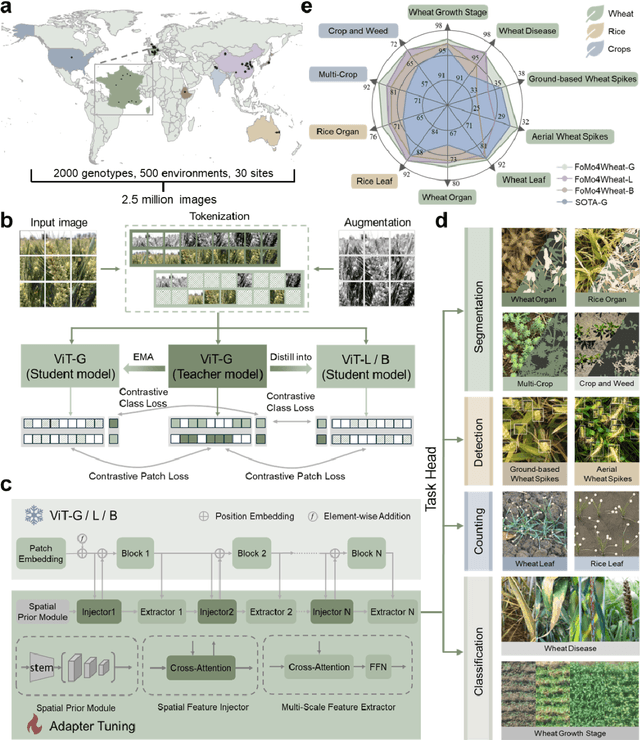
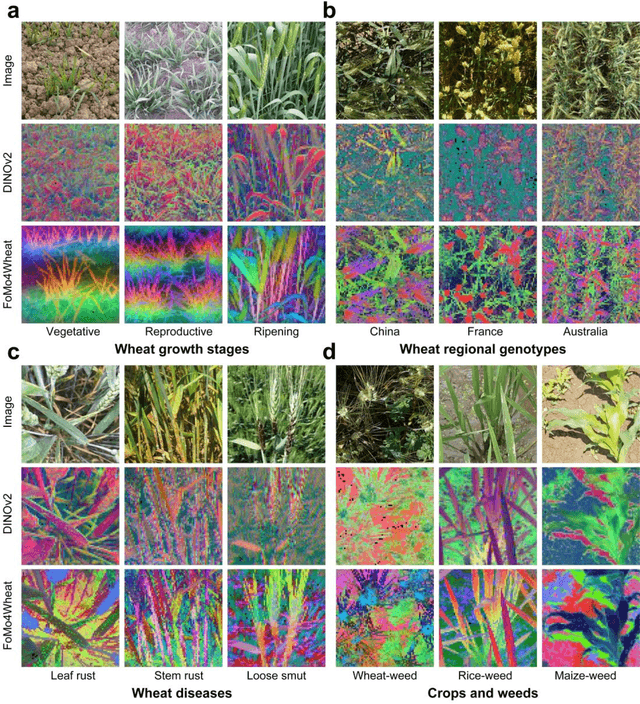
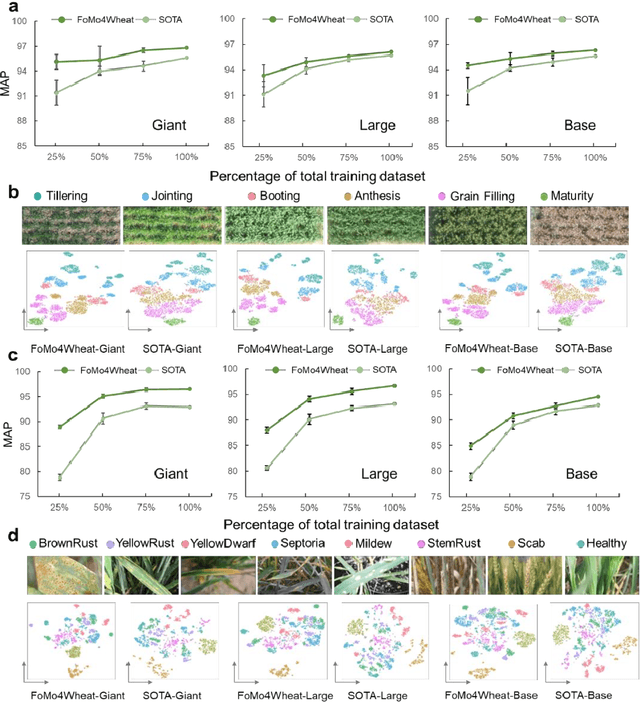
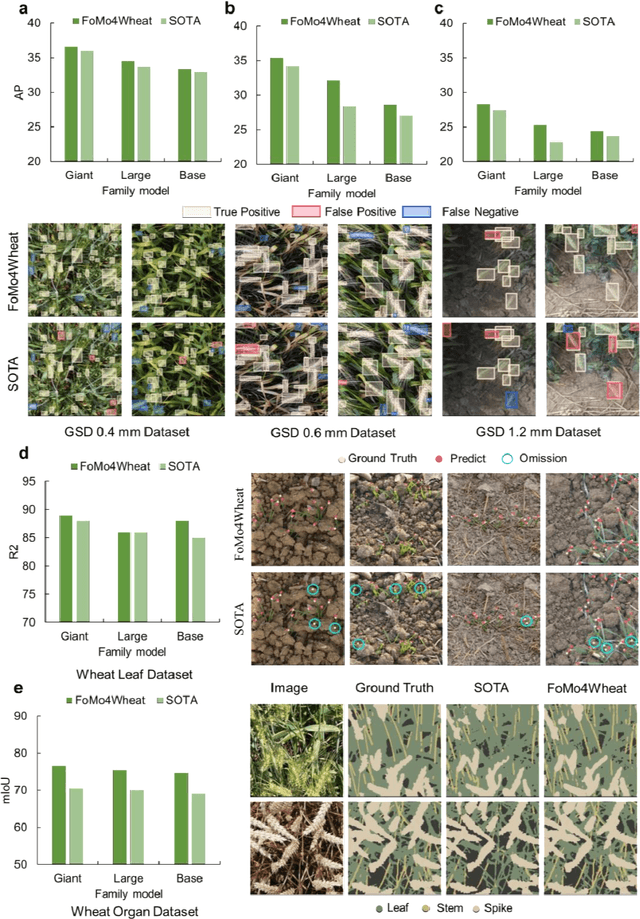
Abstract:Vision-driven field monitoring is central to digital agriculture, yet models built on general-domain pretrained backbones often fail to generalize across tasks, owing to the interaction of fine, variable canopy structures with fluctuating field conditions. We present FoMo4Wheat, one of the first crop-domain vision foundation model pretrained with self-supervision on ImAg4Wheat, the largest and most diverse wheat image dataset to date (2.5 million high-resolution images collected over a decade at 30 global sites, spanning >2,000 genotypes and >500 environmental conditions). This wheat-specific pretraining yields representations that are robust for wheat and transferable to other crops and weeds. Across ten in-field vision tasks at canopy and organ levels, FoMo4Wheat models consistently outperform state-of-the-art models pretrained on general-domain dataset. These results demonstrate the value of crop-specific foundation models for reliable in-field perception and chart a path toward a universal crop foundation model with cross-species and cross-task capabilities. FoMo4Wheat models and the ImAg4Wheat dataset are publicly available online: https://github.com/PheniX-Lab/FoMo4Wheat and https://huggingface.co/PheniX-Lab/FoMo4Wheat. The demonstration website is: https://fomo4wheat.phenix-lab.com/.
ELV-Halluc: Benchmarking Semantic Aggregation Hallucinations in Long Video Understanding
Aug 29, 2025Abstract:Video multimodal large language models (Video-MLLMs) have achieved remarkable progress in video understanding. However, they remain vulnerable to hallucination-producing content inconsistent with or unrelated to video inputs. Previous video hallucination benchmarks primarily focus on short-videos. They attribute hallucinations to factors such as strong language priors, missing frames, or vision-language biases introduced by the visual encoder. While these causes indeed account for most hallucinations in short videos, they still oversimplify the cause of hallucinations. Sometimes, models generate incorrect outputs but with correct frame-level semantics. We refer to this type of hallucination as Semantic Aggregation Hallucination (SAH), which arises during the process of aggregating frame-level semantics into event-level semantic groups. Given that SAH becomes particularly critical in long videos due to increased semantic complexity across multiple events, it is essential to separate and thoroughly investigate the causes of this type of hallucination. To address the above issues, we introduce ELV-Halluc, the first benchmark dedicated to long-video hallucination, enabling a systematic investigation of SAH. Our experiments confirm the existence of SAH and show that it increases with semantic complexity. Additionally, we find that models are more prone to SAH on rapidly changing semantics. Moreover, we discuss potential approaches to mitigate SAH. We demonstrate that positional encoding strategy contributes to alleviating SAH, and further adopt DPO strategy to enhance the model's ability to distinguish semantics within and across events. To support this, we curate a dataset of 8K adversarial data pairs and achieve improvements on both ELV-Halluc and Video-MME, including a substantial 27.7% reduction in SAH ratio.
First Place Solution to the MLCAS 2025 GWFSS Challenge: The Devil is in the Detail and Minority
Aug 24, 2025Abstract:In this report, we present our solution during the participation of the MLCAS 2025 GWFSS Challenge. This challenge hosts a semantic segmentation competition specific to wheat plants, which requires to segment three wheat organs including the head, leaf, and stem, and another background class. In 2025, participating a segmentation competition is significantly different from that in previous years where many tricks can play important roles. Nowadays most segmentation tricks have been well integrated into existing codebases such that our naive ViT-Adapter baseline has already achieved sufficiently good performance. Hence, we believe the key to stand out among other competitors is to focus on the problem nature of wheat per se. By probing visualizations, we identify the key -- the stem matters. In contrast to heads and leaves, stems exhibit fine structure and occupy only few pixels, which suffers from fragile predictions and class imbalance. Building on our baseline, we present three technical improvements tailored to stems: i) incorporating a dynamic upsampler SAPA used to enhance detail delineation; ii) leveraging semi-supervised guided distillation with stem-aware sample selection to mine the treasure beneath unlabeled data; and iii) applying a test-time scaling strategy to zoom in and segment twice the image. Despite being simple, the three improvements bring us to the first place of the competition, outperforming the second place by clear margins. Code and models will be released at https://github.com/tiny-smart/gwfss25.
Video Individual Counting With Implicit One-to-Many Matching
Jun 16, 2025



Abstract:Video Individual Counting (VIC) is a recently introduced task that aims to estimate pedestrian flux from a video. It extends conventional Video Crowd Counting (VCC) beyond the per-frame pedestrian count. In contrast to VCC that only learns to count repeated pedestrian patterns across frames, the key problem of VIC is how to identify co-existent pedestrians between frames, which turns out to be a correspondence problem. Existing VIC approaches, however, mainly follow a one-to-one (O2O) matching strategy where the same pedestrian must be exactly matched between frames, leading to sensitivity to appearance variations or missing detections. In this work, we show that the O2O matching could be relaxed to a one-to-many (O2M) matching problem, which better fits the problem nature of VIC and can leverage the social grouping behavior of walking pedestrians. We therefore introduce OMAN, a simple but effective VIC model with implicit One-to-Many mAtchiNg, featuring an implicit context generator and a one-to-many pairwise matcher. Experiments on the SenseCrowd and CroHD benchmarks show that OMAN achieves the state-of-the-art performance. Code is available at \href{https://github.com/tiny-smart/OMAN}{OMAN}.
LPO: Towards Accurate GUI Agent Interaction via Location Preference Optimization
Jun 11, 2025

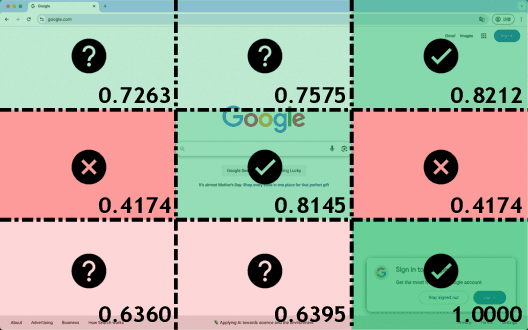
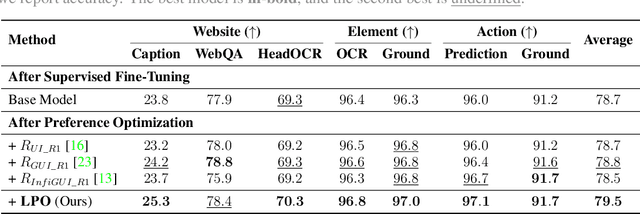
Abstract:The advent of autonomous agents is transforming interactions with Graphical User Interfaces (GUIs) by employing natural language as a powerful intermediary. Despite the predominance of Supervised Fine-Tuning (SFT) methods in current GUI agents for achieving spatial localization, these methods face substantial challenges due to their limited capacity to accurately perceive positional data. Existing strategies, such as reinforcement learning, often fail to assess positional accuracy effectively, thereby restricting their utility. In response, we introduce Location Preference Optimization (LPO), a novel approach that leverages locational data to optimize interaction preferences. LPO uses information entropy to predict interaction positions by focusing on zones rich in information. Besides, it further introduces a dynamic location reward function based on physical distance, reflecting the varying importance of interaction positions. Supported by Group Relative Preference Optimization (GRPO), LPO facilitates an extensive exploration of GUI environments and significantly enhances interaction precision. Comprehensive experiments demonstrate LPO's superior performance, achieving SOTA results across both offline benchmarks and real-world online evaluations. Our code will be made publicly available soon, at https://github.com/AIDC-AI/LPO.
Period-LLM: Extending the Periodic Capability of Multimodal Large Language Model
May 30, 2025



Abstract:Periodic or quasi-periodic phenomena reveal intrinsic characteristics in various natural processes, such as weather patterns, movement behaviors, traffic flows, and biological signals. Given that these phenomena span multiple modalities, the capabilities of Multimodal Large Language Models (MLLMs) offer promising potential to effectively capture and understand their complex nature. However, current MLLMs struggle with periodic tasks due to limitations in: 1) lack of temporal modelling and 2) conflict between short and long periods. This paper introduces Period-LLM, a multimodal large language model designed to enhance the performance of periodic tasks across various modalities, and constructs a benchmark of various difficulty for evaluating the cross-modal periodic capabilities of large models. Specially, We adopt an "Easy to Hard Generalization" paradigm, starting with relatively simple text-based tasks and progressing to more complex visual and multimodal tasks, ensuring that the model gradually builds robust periodic reasoning capabilities. Additionally, we propose a "Resisting Logical Oblivion" optimization strategy to maintain periodic reasoning abilities during semantic alignment. Extensive experiments demonstrate the superiority of the proposed Period-LLM over existing MLLMs in periodic tasks. The code is available at https://github.com/keke-nice/Period-LLM.
MCTSr-Zero: Self-Reflective Psychological Counseling Dialogues Generation via Principles and Adaptive Exploration
May 29, 2025Abstract:The integration of Monte Carlo Tree Search (MCTS) with Large Language Models (LLMs) has demonstrated significant success in structured, problem-oriented tasks. However, applying these methods to open-ended dialogues, such as those in psychological counseling, presents unique challenges. Unlike tasks with objective correctness, success in therapeutic conversations depends on subjective factors like empathetic engagement, ethical adherence, and alignment with human preferences, for which strict "correctness" criteria are ill-defined. Existing result-oriented MCTS approaches can therefore produce misaligned responses. To address this, we introduce MCTSr-Zero, an MCTS framework designed for open-ended, human-centric dialogues. Its core innovation is "domain alignment", which shifts the MCTS search objective from predefined end-states towards conversational trajectories that conform to target domain principles (e.g., empathy in counseling). Furthermore, MCTSr-Zero incorporates "Regeneration" and "Meta-Prompt Adaptation" mechanisms to substantially broaden exploration by allowing the MCTS to consider fundamentally different initial dialogue strategies. We evaluate MCTSr-Zero in psychological counseling by generating multi-turn dialogue data, which is used to fine-tune an LLM, PsyLLM. We also introduce PsyEval, a benchmark for assessing multi-turn psychological counseling dialogues. Experiments demonstrate that PsyLLM achieves state-of-the-art performance on PsyEval and other relevant metrics, validating MCTSr-Zero's effectiveness in generating high-quality, principle-aligned conversational data for human-centric domains and addressing the LLM challenge of consistently adhering to complex psychological standards.
Hunyuan-TurboS: Advancing Large Language Models through Mamba-Transformer Synergy and Adaptive Chain-of-Thought
May 21, 2025Abstract:As Large Language Models (LLMs) rapidly advance, we introduce Hunyuan-TurboS, a novel large hybrid Transformer-Mamba Mixture of Experts (MoE) model. It synergistically combines Mamba's long-sequence processing efficiency with Transformer's superior contextual understanding. Hunyuan-TurboS features an adaptive long-short chain-of-thought (CoT) mechanism, dynamically switching between rapid responses for simple queries and deep "thinking" modes for complex problems, optimizing computational resources. Architecturally, this 56B activated (560B total) parameter model employs 128 layers (Mamba2, Attention, FFN) with an innovative AMF/MF block pattern. Faster Mamba2 ensures linear complexity, Grouped-Query Attention minimizes KV cache, and FFNs use an MoE structure. Pre-trained on 16T high-quality tokens, it supports a 256K context length and is the first industry-deployed large-scale Mamba model. Our comprehensive post-training strategy enhances capabilities via Supervised Fine-Tuning (3M instructions), a novel Adaptive Long-short CoT Fusion method, Multi-round Deliberation Learning for iterative improvement, and a two-stage Large-scale Reinforcement Learning process targeting STEM and general instruction-following. Evaluations show strong performance: overall top 7 rank on LMSYS Chatbot Arena with a score of 1356, outperforming leading models like Gemini-2.0-Flash-001 (1352) and o4-mini-2025-04-16 (1345). TurboS also achieves an average of 77.9% across 23 automated benchmarks. Hunyuan-TurboS balances high performance and efficiency, offering substantial capabilities at lower inference costs than many reasoning models, establishing a new paradigm for efficient large-scale pre-trained models.
MonoSplat: Generalizable 3D Gaussian Splatting from Monocular Depth Foundation Models
May 21, 2025Abstract:Recent advances in generalizable 3D Gaussian Splatting have demonstrated promising results in real-time high-fidelity rendering without per-scene optimization, yet existing approaches still struggle to handle unfamiliar visual content during inference on novel scenes due to limited generalizability. To address this challenge, we introduce MonoSplat, a novel framework that leverages rich visual priors from pre-trained monocular depth foundation models for robust Gaussian reconstruction. Our approach consists of two key components: a Mono-Multi Feature Adapter that transforms monocular features into multi-view representations, coupled with an Integrated Gaussian Prediction module that effectively fuses both feature types for precise Gaussian generation. Through the Adapter's lightweight attention mechanism, features are seamlessly aligned and aggregated across views while preserving valuable monocular priors, enabling the Prediction module to generate Gaussian primitives with accurate geometry and appearance. Through extensive experiments on diverse real-world datasets, we convincingly demonstrate that MonoSplat achieves superior reconstruction quality and generalization capability compared to existing methods while maintaining computational efficiency with minimal trainable parameters. Codes are available at https://github.com/CUHK-AIM-Group/MonoSplat.
Sage Deer: A Super-Aligned Driving Generalist Is Your Copilot
May 15, 2025Abstract:The intelligent driving cockpit, an important part of intelligent driving, needs to match different users' comfort, interaction, and safety needs. This paper aims to build a Super-Aligned and GEneralist DRiving agent, SAGE DeeR. Sage Deer achieves three highlights: (1) Super alignment: It achieves different reactions according to different people's preferences and biases. (2) Generalist: It can understand the multi-view and multi-mode inputs to reason the user's physiological indicators, facial emotions, hand movements, body movements, driving scenarios, and behavioral decisions. (3) Self-Eliciting: It can elicit implicit thought chains in the language space to further increase generalist and super-aligned abilities. Besides, we collected multiple data sets and built a large-scale benchmark. This benchmark measures the deer's perceptual decision-making ability and the super alignment's accuracy.
 Add to Chrome
Add to Chrome Add to Firefox
Add to Firefox Add to Edge
Add to Edge